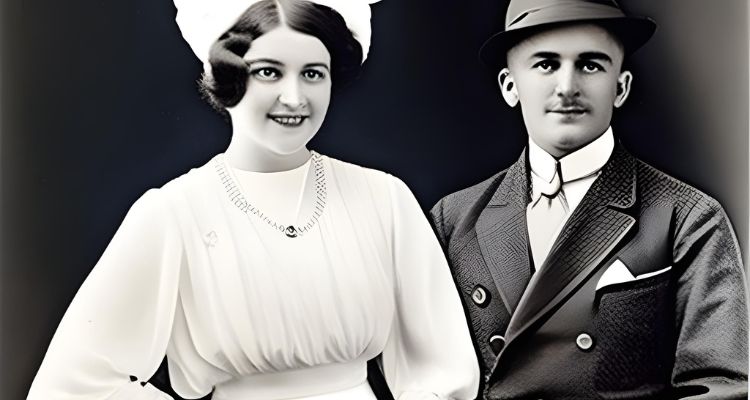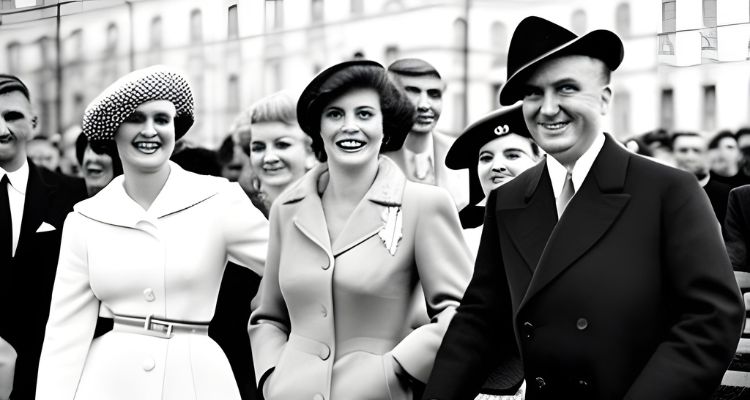1920s Russian Fashion is more than simply a fun hobby; it’s a window into the culture, values, and times of a certain moment. Fashion has a long history of serving as a potent vehicle for social commentary, political commentary, and self-expression. Russia experienced enormous turmoil during the 1920s as a result of the Bolshevik Revolution and the establishment of the Soviet Union. Significant fashion changes occurred during this time as new designs and challenges to conventional clothing patterns developed.
This article will examine how 1920s Russian Fashion was influenced by both folk traditions and revolutionary transformation. Understanding the significance of clothes and their effects on society may be improved by looking at the relationships between fashion, culture, and politics. In the end, researching Russian fashion from the 1920s gives light on both the past and the present and future of fashion and culture.
I. Russian Fashion before the 1920s
The history of 1920s Russian Fashion precedes the 20th century and is extensive. For many years, Russian clothing was heavily influenced by European fashion trends, particularly those of France. In the 19th century, wealthy Russians often traveled to Paris to purchase the latest styles, which were then replicated by local tailors. However, traditional clothing styles remained prevalent among the working class and rural populations.
Traditional Russian clothing was characterized by its practicality and functionality, with garments designed to withstand harsh weather conditions. The most iconic traditional garment is the sarafan, a sleeveless dress worn by women that were typically made of linen or cotton. Men wore long shirts known as kosovorotka, with a collar that could be turned up to protect the neck from the sun. Both men and women also wore a type of knee-length boot called a valenki, which was made of felted wool and often worn with woolen socks.
Early in the 20th century, as nationalist emotions intensified, the impact of European fashion on Russia started to decline. A new movement called the “Russian style” emerged, which sought to revive traditional clothing and incorporate folk motifs into contemporary designs. Prior to the political and social turmoil of the Bolshevik Revolution, this movement had an especially large influence in the early 20th century. Yet, rural people continued to dress in traditional ways, and some traditional components, like the women’s kokoshnik headpiece, were still integrated into formal clothes for important occasions.
Overall, the fashion of pre-Revolutionary Russia was a blend of European influences and traditional clothing styles. Yet, when the Bolshevik Revolution ushered in a new period of revolutionary upheaval, the 1920s Russian Fashion would witness a profound transition in Russian fashion.

II. The 1920s: A Time of Revolutionary Change
Due to the Bolshevik Revolution and the creation of the Soviet Union, the 1920s saw a significant change in Russia. Significant fashion changes occurred during this time as new designs and challenges to conventional clothing patterns developed. Fashion played a significant role in the Soviet government’s effort to establish a new socialist culture that was separate from the previous decrepit bourgeois culture.
The development of unisex clothes was one of the biggest shifts in fashion throughout the 1920s. Men and women were encouraged to dress in the same ways, eliminating the traditional gendered differences in clothes. As clothing was no longer a sign of social standing, this was considered a method to advance gender equality and do away with class disparities.
The use of vivid colors and geometric patterns was another significant trend in 1920s Russian clothing. Modernist interpretations of traditional designs were used, and wool and cotton textiles were colored in vivid hues of red, blue, and green. With loose-fitting clothes that were suitable for the severe environment and physical demands of daily living, this type of clothing was useful and practical.
The Soviet government also founded the first recognized fashion institute in Moscow in 1924 in addition to these style adjustments. The institute’s duties included teaching designers and fostering domestic and worldwide interest in Soviet-style clothes. The Soviet fashion industry, which would later create clothes that were both stylish and utilitarian, officially began with this.
Russian fashion underwent a significant transition in the 1920s as new designs and challenges to existing trends developed. The Soviet Union wanted to establish a new socialist culture, and fashion was a key component of this effort. One way that fashion represented the revolutionary shift occurring in Russia was through the development of unisex attire, the use of vivid colors, and geometric designs.
III. Folk Traditions in Russian Fashion
Even though Russian fashion underwent significant changes in the 1920s, folk customs remained a significant influence on clothing trends. The Soviet Union tried to combine folk elements into modern designs because it valued traditional attire as a symbol of national identity.
The development of the so-called “Russian dress” in the middle of the 1920s is one of the most well-known instances of this fashion. The traditional women’s sarafan was the source of inspiration for this dress, which was modernized with asymmetrical hemlines and colorful designs. Women of various ages and socioeconomic backgrounds wore the “Russian dress,” which gained popularity both inside and outside Russia.
The use of needlework and other ornamental components is another instance of how traditional themes were incorporated. Modernist clothing was embellished with traditional embroidery techniques, giving it a folk art feel. This fashion was most prevalent in the 1930s, a time when the Soviet authorities supported the growth of folk art as a way to advance national culture.
In addition to these aesthetic components, many Russians continued to dress in traditional fashions, especially in rural regions. For instance, the kokoshnik headpiece continued to be a preferred accessory for ladies and was frequently worn with formal wear on important occasions. Working-class people continue to like traditional footwear like the Valenki boot.
In general, the Soviet Union’s attempts to advance national culture and forge a distinctive socialist look can be seen in the way that folk customs were incorporated into Russian fashion during the 1920s and 1930s. Soviet fashion designers produced apparel that was both functional and fashionable while also honoring the rich cultural legacy of the Russian people by fusing traditional aspects with modernist design.
IV. Soviet Fashion Industry
The Soviet fashion industry began in the 1920s and expanded during the 1930s, eventually becoming an important part of the Soviet economy and culture. The Soviet government recognized the value of fashion as a means of promoting national identity and creating a new socialist culture and invested heavily in the development of the industry.
One of the key institutions in the Soviet fashion industry was the All-Union Fashion House, established in 1935. The Fashion House was in response to designing and producing clothing for both domestic and international markets, employing thousands of designers, tailors, and other workers. The Fashion House was also responsible for training new designers, and its graduates went on to work in fashion houses throughout the Soviet Union.
The Soviet fashion industry was heavily influenced by the government’s policies of planned economy and socialist realism. Clothing was designed to be practical and functional, and the use of luxury materials and designs was discouraged. Instead, Soviet fashion designers focused on creating clothing that was affordable and accessible to all.
The so-called “worker’s suit,” unisex clothing created for factory workers and other laborers, was one of the most famous forms of Soviet fashion. The worker’s suit was made of durable materials such as wool or cotton and was designed to be comfortable and functional. The suit was often paired with a matching cap or hat, creating a distinctive uniform for workers.
Another key trend in Soviet fashion was the use of propaganda imagery and slogans on clothing. Shirts and skirts featured portraits of Soviet leaders like Lenin and Stalin, as well as phrases espousing socialist principles. This trend reflected the Soviet government’s desire to promote a sense of collective identity and patriotism among the Soviet people.
Overall, the Soviet fashion industry was an important part of Soviet culture and society, reflecting the government’s commitment to promoting a new socialist culture and creating a distinctive national identity. The focus on practicality and affordability in Soviet fashion helped to create a style that was accessible to all, while the use of propaganda imagery and slogans helped to reinforce the government’s messages of collective identity and patriotism.

V. Legacy of 1920s Russian Fashion
The influence of 1920s Russian Fashion from the 1920s may still be felt today, both in Russia and throughout the world. The bold designs, folk motifs, and socialist themes of Soviet fashion have influenced designers and fashion trends for decades.
The “Russian dress” is one of the most enduring remnants of Soviet fashion. This classic folk-inspired gown is still worn by ladies in Russia and is a popular choice for costumes and formal dresses. The distinctive design elements of the “Russian dress,” such as bold patterns and asymmetrical hemlines, have also been incorporated into contemporary fashion designs.
The use of propaganda imagery and slogans on clothing has also had a lasting impact on fashion. The trend of using clothing as a means of promoting political or social messages has continued to be popular, with designers creating clothing featuring slogans and images that reflect current political or cultural issues.
The influence of Soviet fashion may also be recognized in the work of modern Russian and international designers. Designers such as Gosha Rubchinskiy and Demna Gvasalia have drawn inspiration from Soviet fashion, incorporating elements of socialist realism and folk motifs into their designs.
Ultimately, the legacy of Soviet fashion may be observed in the importance of dress in expressing national identity and cultural heritage. The Soviet government’s focus on promoting national culture through fashion has had a lasting impact, with designers around the world incorporating traditional motifs and design elements into contemporary fashion.
Overall, the legacy of 1920s Russian fashion is a testament to the enduring power of fashion to reflect and shape culture and society. The bold designs, folk motifs, and socialist themes of Soviet fashion continue to inspire and influence designers and fashion trends today, ensuring that the legacy of Russian fashion will be felt for years to come.
VI. Conclusion
In conclusion, the 1920s Russian Fashionwere a time of significant change and innovation in Russian fashion. The influence of folk traditions, combined with the revolutionary changes brought about by the Soviet government, created a unique and distinctive style that continues to inspire and influence designers today.
The emergence of the Soviet fashion industry, with its focus on practicality and affordability, helped to create a style that was accessible to all, while the use of propaganda imagery and slogans on clothing reinforced the government’s messages of collective identity and patriotism.
The legacy of 1920s Russian fashion can be seen in the enduring popularity of the “Russian dress,” the continued use of propaganda imagery and slogans in fashion, and the influence of Soviet fashion on contemporary designers. It demonstrates fashion’s power to reflect and modify culture and society, as well as the need of maintaining and appreciating the cultural past.
Ultimately, the tale of 1920s Russian Fashion is intriguing and complicated, representing the interaction between tradition and innovation, individual expression and group identity, and culture and politics. It’s a tale that never fails to enthrall and inspire us and serves as a timely reminder of how fashion can communicate the tales of a country and its people.

